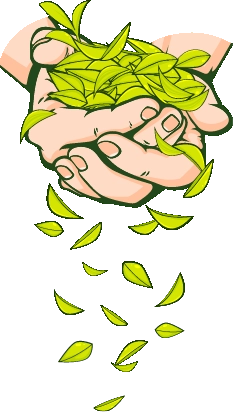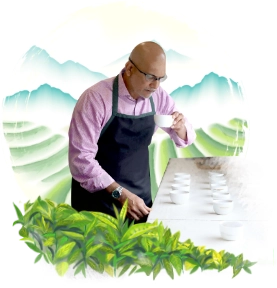How Tea got Spiced…and Then Got Dirty! From Tea to Masala Chai to Dirty Chai
Traditionally, tea was drunk in China and Japan without milk or sugar. For over four centuries, this is what tea meant. In the nineteenth century, this ubiquitous tea was introduced in India by the British…and something happened! The serenely simple tea was mixed with a load of spices, heaps of sugar and oodles milk by the street-smart hot-tea vendors in India. This tranquil tea, the drink of the monks, magically became Masala Chai – the zingy, peppy, spicy, milky concoction – the ultimate mood-lifter and instant-energiser.
And then, in the twenty-first century, adventurist Americans, the ever-inventors and re-inventors, gave Masala Chai a whole new avatar: the Chai Latte, the Chai Tea and…the Dirty Chai.
We trace back those heady days of the British Raj at the turn of the nineteenth century and then travel to America to rediscover this amazing transformation of the world’s oldest beverage!
Tea was a closely held oriental secret till about five hundred years ago. Only in China and Japan tea was it an integral part of culture, lifestyle and tradition. With the age of exploration, as the late medieval period ended and the modern era began, tea started to be smuggled out of China and made its first appearance in the West. Here, like everything oriental, it quickly captured the popular imagination. Soon, the Dutch and the Portuguese were importing large volumes of tea from China to meet the insatiable demand from Europe, Britain and the new world – America.
Enter the Honourable Company : The British East India Company
The British were late entrants in the international tea trade. With growing power and prowess of the world’s first truly multinational conglomerate – The British East India Company, the British soon started dominating the global tea trade, having a monopoly of importing tea from China – the only known source of tea then. But when this monopoly ended with the Opium Wars by the end of the eighteenth century, the British were desperately looking at alternative sources of tea.
As usual, they looked for answers at India.
After nearly fifty years of relentless efforts, they found an indigenous variety of wild tea trees in remote jungles of Assam. By 1830s, tea was being planted commercially all over Assam, and around 1850, the British had also successfully started tea plantation in colder Darjeeling using the delicate Chinese tea bushes.
The success of growing tea Indian tea meant that the British now had a firm grip on supply – all they had to do was find new consumers. And where else to find new customers but…India!
Tea Spiced Up with Indian Ingenuity
Tea drinking in India was introduced and heavily promoted around the end of the nineteenth century, so much so that it was even offered free. However, most Indians still found the price of tea to be high, and therefore, resorted to the ‘leftover’ tea – the inferior dusts and smaller leaves which were substantially cheaper.
It was another early example of the India ingenuity that transformed the elite British tea into a uniquely Indian drink – the Masala Chai. Indians had almost perfected the art of using spices in their food to enhance its taste and flavour as well as augment health benefits. From cinnamon to cardamom, from cloves to pepper and from nutmeg and ginger, spices were used raw and roasted, whole and grounded, and in a myriad of combinations. Masala is generally used to denote a collection of spices in India.
The street-smart tea vendors soon started adding a variety of masala to tea to make it to add layers of tastes and flavour the milk, and to hide the plain and weak low quality tea used! It is generally believed that traders from Gujarat, Maharashtra and Bengal were instrumental in adding spices to their tea. Some added ginger, especially in winters, while others added cardamom, and some, more than one spice. They also started adding lots of milk and sugar, both of which were traditionally much-loved by Indians. Milk gave additional nutrition, while sugar gave that ready burst of energy. Boiling made it totally safe, killing all bacteria. The result was steamy, spicy, sweet Masala Chai, which was absolutely different to the English Tea and totally unrecognisable to the Chinese and Japanese teas.
Ramayana and Chai?
There is an interesting myth around the origin of chai in India : it is said that magical and mythical Sanjeevani plant mentioned in epic Ramayana, used to revive Lord Ram’s unconscious brother, Lakshman, was none other than – leaves of Indian tea plant. Serving a combination of wild tea leaves brewed with spices and herbs was also customary in the royal courts – from Emperor Ashok to Harshvardhan. Was this the world’s first Masala Chai?
In the state of Assam in North East India, where tea plants were found to be growing in the wild by Charles and Alexander Bruce, Laal Cha (Red Tea) brewed in hot water with wild tea leaves was always served as a welcome drink.
From Masala Chai to Chai Latte
With the rise of the hippie culture in the 1960s, India became a favourite destination for its exoticism. As hordes of impressed and indianised hippies returned home, they carried with them the many wonderful experiences and memories, including the Masala Chai. This is how the West first got its taste of Masala Chai.
But it was with the café revolution that became placed the humble Masala Chai on the global pedestal as a fashionable and stylish new drink. It was introduced as Chai Latte at top cafés in the USA, and soon became highly sought after as a lesser caffeine, exotically Indian hot drink. Unlike the Indian Masala Chai, the Chai Latte is a combination of many spices with lots of sugar, milk and flavoured syrups. Over the years, Chai Latte has grown in popularity and emerged from a niche presence to a mainstream category. In the process, it has also changed its name : from Chai Latte to the tautologous Chai Tea, which actually means Tea Tea! Chai Tea is today a high-growth category of tea in the USA with top brands offering their own blends of black tea with spices and herbs. The combinations are endless as blenders offer innovative blends using variety of teas – black, green, oolongs with a combination of spices and herbs like turmeric, ginger, moringa, ashwagandha and holy basil herbals.
From Chai to Dirty Chai
There is nothing either dirty or scandalous about Dirty Chai at all! In fact, it is a brilliant fusion of coffee and tea, marketing and innovation, artistry and wizardry. Till recently, at the top of the menu of the largest coffee chain in the world, Dirty Chai is said to have been accidentally invented in Convent Garden in England in the 1990s. It so happened that the lady accidentally poured a shot of espresso while making Chai Latte for an American, who decided, in true American spirit of adventurism, to try it…and he found it to be amazing.
Since then, Dirty Chai has become a uniquely American phenomenon and is served all over cafés in the USA. It is also called Java Chai, Red-eye Chai, Turbo-charger Chai and even the Tough-guy Chai.
Here is a quick recipe for Dirty Chai
Hot Dirty Chai
Brew a strong cup of tea using Assam Whole Leaf teas with spices of choice : cardamom, cinnamon, cloves, nutmeg, pepper, mace and ginger. Add a pinch of turmeric powder to boost immunity.
If you find this too cumbersome, just pick up Chai Tea mix pack.
Once brewed for 4-5 minutes, strain. Pour in a single or double shot of espresso.
Add steamed milk and sugar to taste
Top it with frothed milk.
Sprinkle cinnamon powder.
Iced Dirty Chai
Brew as in hot Dirty Chai.
Add a single or double shot of espresso.
Allow the mix to come down to room temperature.
Take a tall, heavy-bottom glass. Fill it up with ice cubes.
Slowly, pour the mix over the ice.
Add sugar to taste.
Pour in cold milk.
Top with a dollop of thick cream.
From the serene and simple green tea prepared by zen monks 5,000 years ago to the Indian Masala Chai to the American Dirty Chai, tea has certainly come a long way.

Tea is a religion in the art of life.

